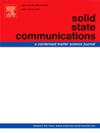Synergistic improvement of polarization and energy storage density of Ba0.4Sr0.6TiO3 ceramics by doping Sr0.7Bi0.2TiO3
IF 2.1
4区 物理与天体物理
Q3 PHYSICS, CONDENSED MATTER
引用次数: 0
Abstract
Although dielectric ceramics have significant application in high-power energy storage devices, it remains to be limited by the low energy storage density. Ba0.4Sr0.6TiO3 ceramics has attract a great deal of attention in this area, due to its low dielectric loss, diffuse dielectric properties and ultra-high energy storage efficiency. While its energy storage density is still very limited, despite be made into MLCC. In this work, Sr0.7Bi0.2TiO3 was introduced to improve the energy performance of Ba0.4Sr0.6TiO3. Thanks to the defective dipoles and electronic polarization of Bi3+ after doping Sr0.7Bi0.2TiO3, the effective energy storage density of 0.9Ba0.4Sr0.6TiO3-0.1Sr0.7Bi0.2TiO3 ceramic can reach to 3.234 J/cm3, with the electric breakdown strength increasing to 380 kV/cm. This work supplied a new material for high power density ceramic. Meanwhile, it supplied a new way to enhance the energy storage performance of ceramics.
掺杂Sr0.7Bi0.2TiO3协同改善Ba0.4Sr0.6TiO3陶瓷的极化和储能密度
尽管介电陶瓷在大功率储能器件中有着重要的应用,但其储能密度仍然受到限制。Ba0.4Sr0.6TiO3陶瓷由于具有低介电损耗、扩散介电性能和超高的储能效率,在这一领域受到了广泛的关注。而其储能密度仍然非常有限,尽管可以制成MLCC。在本工作中,为了提高Ba0.4Sr0.6TiO3的能量性能,引入了Sr0.7Bi0.2TiO3。掺入Sr0.7Bi0.2TiO3后,由于Bi3+的偶极子缺陷和电子极化,0.9Ba0.4Sr0.6TiO3-0.1Sr0.7Bi0.2TiO3陶瓷的有效储能密度可达3.234 J/cm3,电击穿强度提高到380 kV/cm。这项工作为高功率密度陶瓷提供了一种新的材料。同时,为提高陶瓷的储能性能提供了一条新的途径。
本文章由计算机程序翻译,如有差异,请以英文原文为准。
求助全文
约1分钟内获得全文
求助全文
来源期刊

Solid State Communications
物理-物理:凝聚态物理
CiteScore
3.40
自引率
4.80%
发文量
287
审稿时长
51 days
期刊介绍:
Solid State Communications is an international medium for the publication of short communications and original research articles on significant developments in condensed matter science, giving scientists immediate access to important, recently completed work. The journal publishes original experimental and theoretical research on the physical and chemical properties of solids and other condensed systems and also on their preparation. The submission of manuscripts reporting research on the basic physics of materials science and devices, as well as of state-of-the-art microstructures and nanostructures, is encouraged.
A coherent quantitative treatment emphasizing new physics is expected rather than a simple accumulation of experimental data. Consistent with these aims, the short communications should be kept concise and short, usually not longer than six printed pages. The number of figures and tables should also be kept to a minimum. Solid State Communications now also welcomes original research articles without length restrictions.
The Fast-Track section of Solid State Communications is the venue for very rapid publication of short communications on significant developments in condensed matter science. The goal is to offer the broad condensed matter community quick and immediate access to publish recently completed papers in research areas that are rapidly evolving and in which there are developments with great potential impact.
 求助内容:
求助内容: 应助结果提醒方式:
应助结果提醒方式:


